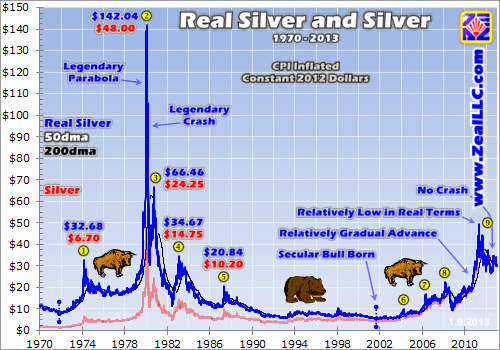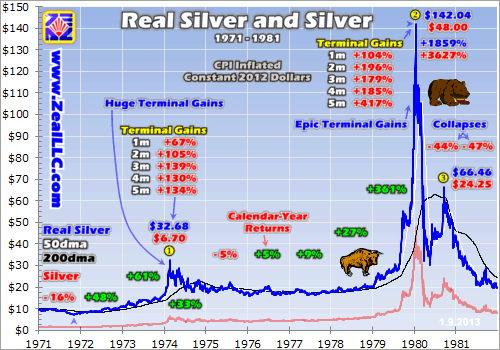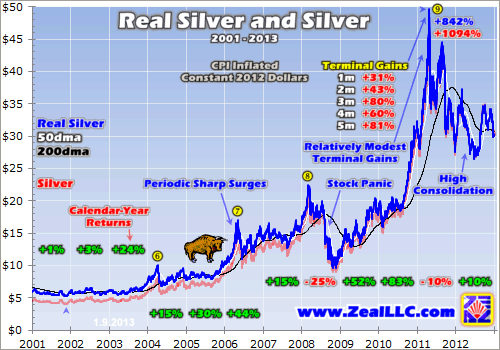|
|
|||||||
|
|
|
|
|
|
|
|
|
|
Real Silver Highs 4 Adam Hamilton January 11, 2013 2832 Words
Silver bearishness has naturally mushroomed following this metalís rough December. A growing chorus is declaring silverís secular bull finished, implying it must have peaked after silverís dazzling April 2011 surge. But secular bulls climax in popular speculative manias, which dwarf the silver action of a couple springs ago. Looking at silver in real inflation-adjusted terms drives home the point its bull is far from over.
For any multi-decade price comparison, adjusting for inflation is essential. A dollar today is worth a lot less than a dollar in the past. The Federal Reserve keeps conjuring up new fiat dollars out of thin air, inflating the money supply. As it grows faster than the underlying economy, relatively more dollars compete for relatively less goods and services. This monetary inflation bids up the prices of everything.
And to get an idea of what a secular-bull-ending popular speculative mania in silver really looks like, we have to travel back to the last one in early 1980. Silver peaked at the then-breathtaking level of $48, which no longer sounds extreme. But a dollar back then went a heck of a lot farther than a dollar today. The intervening three decades of relentless inflation have greatly eroded each dollarís purchasing power.
Back when silverís last secular bull climaxed, the US median household income was under $18k! Today it is around $50k. Across the nation new houses averaged just $76k while new cars generally ran less than $6k. A candy bar cost a quarter. It is grossly misleading to look at decades-past prices without first converting them into todayís dollars which we all understand. That creates a righteous apples-to-apples comparison.
Unfortunately the most widely accepted inflation gauge today is the US Consumer Price Index. Even though it greatly understates true monetary inflation for political reasons, it is still the inflation yardstick that Wall Street accepts. Using the horribly flawed CPI to recast past silver prices into todayís dollars is actually very conservative. Since this construct lowballs inflation, it really understates silverís last mania.
This first chart looks at the last four decades or so of silver prices, showing what a real bull-killing popular speculative mania looks like in todayís dollars. The nominal (not inflation-adjusted) silver price is shown in red, while the real (inflation-adjusted) silver price is superimposed in blue. This uses the CPI to recast silver prices in constant November 2012 dollars, the most recent monthly CPI data currently available.
Silver has always been a hyper-speculative metal, which greatly amplifies the magnitude of its popular speculative manias that climax secular bulls. The terminal ascent of its last one in late 1979 and early 1980 was mind-boggling. It skyrocketed vertically in a legendary parabola, and then immediately collapsed in a legendary crash. In todayís dollars, silverís January 21st, 1980 high was actually over $142 per ounce!
A popular speculative mania is a far cry from even a strong bull-market upleg, theyíre entirely different beasts. During these ultra-rare events, an entire population (not just investors) becomes enthralled with a rocketing price. It comes to be seen as a sure thing, an easy path to quickly multiplying wealth. This leads to crazy behaviors that would never happen in normal times, often called the ďmadness of crowdsĒ.
The mainstream media covers the rocketing price excessively. It becomes the hip topic of choice in nearly all conversations. People who never invested in that asset before literally borrow money (even mortgage their houses) to buy as much as they can as quick as they can. People are hypnotized by the rapid gains, foolishly convincing themselves that the price will continue surging forever. It is pure insanity.
While the spring 2011 silver upleg was certainly powerful, it was nothing like a popular speculative mania. The only people captivated by silverís advance then were a small fraction of total investors. Silver was not covered in the mainstream media and even CNBC gave it little airtime. Silver was certainly very overbought and needed to correct, but this bullís latest peak was not driven by the general population.
And this real silver chart really drives home that critical point that guts the bearsí thesis that silverís bull has ended. Silverís advance in todayís secular bull has been much more gradual than the 1970s one. Its April 2011 peak near $50 in todayís dollars was only about a third of its January 1980 one. And afterwards, there was no crash like we saw in 1980. Silver consolidated high and held most of its gains.
Provocatively, todayís silver bull ought to ultimately see a popular-speculative-mania-driven real peak that far exceeds January 1980ís. Back then the rest of the world was much poorer, so most of silverís mania was from American and European buying. Today Asia is far wealthier in real terms, with growing middle and investor classes that have a deep cultural affinity for precious metals. Imagine when they go crazy for silver!
The Information Age will also contribute to a bigger speculative mania. Several decades ago financial information was hard to come by, but today it is ubiquitous. When silver eventually starts marching higher in its secular bullís mammoth terminal ascent, the Internet will be abuzz with hyper-bullish commentary. This will seduce in far more normal non-investor people than participated in the last mania.
Silverís latest April 2011 peak, the upleg leading up to it, and the secular bull that spawned that upleg truly look nothing like the last secular bull. Silver still remains a tiny alternative investment scorned by Wall Street and ignored by mainstream Americans. It has yet to capture the popular imagination as the ultimate sure-thing investment. We havenít seen anything close to a popular speculative mania yet.
While that first chart revealed how small and gradual silverís current secular bull has looked in constant-dollar terms, it is also important to consider the terminal gains. The signature of manias is the sheer speed and magnitude of the rallies they ignite. When a vast new pool of capital starts deluging into an asset class that is too small to handle such demand, the resulting price spike defies imagination.
This second chart zooms in on silverís last secular bull rendered in todayís dollars. It notes the terminal gains in silverís two largest surges of that bull, in nominal terms since these are short multi-month spans. It also shows silverís nominal calendar-year returns, which also strongly suggest silverís current secular bull is far from over. The contrast between silverís last secular bull and todayís couldnít be starker.
These final two charts are best considered as a pair, as together they really highlight just how immature silverís current secular bull looks. Since weíre on the popular-speculative-mania thread, letís start with terminal gains. I broke them down into monthly increments, showing how much silver surged in the final month, 2 months, 3 months, 4 months, and 5 months leading into major toppings. The results are telling.
The first huge surge of silverís last secular bull happened in early 1974. In the final month before silverís peak, it surged 67%! Donít let that slide by without thinking about it first. A 67% gain in a single month is breathtaking. If that happened today starting at silver near $30, it would be over $50 just 4 weeks from now. The final 5 months before that 1974 peak saw silver rocket 134% higher, once again incredible.
But as amazing as that 1974 surge proved, it wasnít a popular speculative mania. Mainstream investors who never before thought about or bought silver didnít flood in. That didnít happen until late 1979 and early 1980. And the terminal gains seen in that last mania were truly epic. Silver skyrocketed 104% higher in that surgeís final month alone! In the final 5 months, its price blasted an insane 417% higher!
If you scroll down to the next chart showing todayís secular silver bull, the terminal gains seen leading into its latest April 2011 peak paled in comparison. Despite how exciting and profitable silverís spring-2011 surge proved, this hyper-speculative metal only rallied 31% in that uplegís final month and 81% in its final 5. This is less than a third and less than a fifth of what was seen in the last speculative mania!
Secular bulls donít end until they bloom into a popular speculative mania that sucks in normal everyday non-investors heading into the climax. And when mainstream capital pours into an asset that hasnít seen so much demand before, its price explodes higher with a fury that can never be matched in even the largest normal upleg. The terminal gains in April 2011 were nowhere near popular-mania velocity.
And the aftermath of that flood of popular buying is a crash. Once greed gets so extreme that anyone willing to buy has already bought, only sellers remain. So the mania price promptly collapses. Note above that the silver speculative mania ignited in August 1979 near $27 real. After shooting up to $142 in January 1980, silver was back down near $32 by March 1980. The entire mania was wiped out in just 2 months!
Contrast this with the April 2011 aftermath. That large upleg really started humming in September 2010 after breaking above $20 real. It peaked just under $50 in todayís dollars in April 2011. But despite the subsequent near-crash, the worst silver levels seen in the couple months after the peak were still near $34 real. So instead of the entire upleg being wiped out, nearly half its gains survived even at worst.
And the longer-term aftermath of a popular mania is even more severe. When people get fooled into buying into the top near mania-extreme prices, the subsequent losses are so brutal that they never come back. In calendar 1980 and 1981, silver collapsed by 44% and 47% respectively! The general public that bought in and fueled the mania was so demoralized that they aggressively dumped silver for years to come.
Meanwhile in 2011 and 2012, silver merely lost 10% and then gained 10%. Such modest losses after a big upleg are definitely not what the devastating aftermath of a popular speculative mania looks like. Instead of collapsing like after the 1980 bull-killing peak, silver simply consolidated high in recent years holding on to most of its secular bullís gains. And they themselves offer another major contrast.
Popular speculative manias are so massive that they drive their underlying secular bullsí gains stratospheric. In nominal terms silver launched a staggering 3627% higher in its last secular bull, and this translates into a still-amazing 1859% in real inflation-adjusted terms. When the public falls in love with and floods into an asset, the resulting bull-market gains end up being gargantuan beyond belief.
In todayís secular bull, as of its latest April 2011 peak silver was only up 1094% in nominal terms and 842% in real terms. These are less than a third and a half respectively of the precedent the last secular silver bull set. And remember that happened without significant Asian participation in a much-poorer world with vastly less paper money, and without the Internet to whip up non-investors into a silver-lusting frenzy of new buying.
And finally consider silverís calendar-year returns. Back in the 1970s they were erratic, with down years and mild up years sprinkled between the big up years that made the entire bull. As a speculatorsí playground, silver sure doesnít rise in a nice straight line. It surges dramatically and then consolidates for a long time. These consolidations shake out naive investors who donít understand silverís nature.
And silverís annual performances have been erratic in this bull too as this final chart shows. Sometimes it is up big, sometimes it is down big. But even large down years like 2008ís stock panic donít prematurely end silverís secular bull. It bounces right back as sentiment recovers, something to remember today in this current environment filled with silver fear, despair, and bearishness. Silverís gains arenít smooth.
But there is definitely a mean-reversion tendency in silverís returns. Weak years are generally followed by strong years, and vice versa. After 2008ís stock panic crushed it, silver soared 52% in 2009 and 83% in 2010. And those incredible years led into the high consolidation of 2011 and 2012, with their 10% loss and 10% gain. So if silverís secular bull is indeed alive and well, it is certainly due to surge once again in 2013.
And thereís one more thing to note in this real-silver comparison. Todayís secular silver bull, while erratic, is much more consistent than the 1970s one proved. Silverís gains have been more gradual, the periodic sharp surges as greed waxes excessive havenít been extreme like the 1974 example. This implies todayís bull has a much larger investor constituency deploying capital more gradually over time.
Thus todayís bull is considerably more robust, it has a stronger foundation than the 1970s one. This supports the thesis that todayís secular silver bull will ultimately prove larger than the last one. The better the foundation, the more investor capital deployed before that crazy popular-speculative-mania phase sets in, the higher silver can potentially rocket when the general public finally comes storming in.
So despite all the silver bearishness out there today spawned by silverís recent weakness, its secular bull looks far from over. Popular speculative manias cap secular bulls, and though the spring-2011 upleg was strong it was nothing remotely close to mania-caliber. Silver is going to see much higher highs, dwarfing April 2011ís near $50 real, before this secular bull has fully run its course and finally gives up its ghost.
Interestingly, silver is already in a young new upleg that most traders refuse to see because they are blinded by todayís bearishness. While this metal was pounded back down near $30 in December, just under its 200dma, it spent much of last summer languishing around $27. Silver is slow to gather steam, with gradual early-upleg buying slowly building momentum into the exciting large late-upleg surges.
And the Fedís new QE3 Treasury monetizations that are just starting this month are wildly bullish for silver. This metal has always been a go-to asset in inflationary times. That last mighty upleg that peaked in April 2011 happened to be largely driven by the Fedís last major inflationary campaign, QE2. So 2013 is shaping up to be an amazing year for silver, and probably even better for the beaten-down silver miners.
When traders are bearish on silver after its slumps, they just abandon the stocks of the companies that bring it to market. The silver stocks plunge to deeply-undervalued levels relative to silver, they are pretty much left for dead. This creates great opportunities to buy low for brave contrarians who understand silverís bullish fundamentals and arenít spooked by temporary weakness. The newest persists today.
Most silver stocks are trading as if the bears are right, as if silver is doomed to grind lower from now to the end of time. But in real terms todayís secular silver bull looks far from over, and silver is early in what is likely to prove its next major upleg. So the excessively gloomy psychology plaguing silver stocks today wonít last. Contrarians who understand this have been buying cheap silver stocks in recent months.
It isnít too late. Last month we published our latest deep-research report on silver juniors, the highest-potential of all silver stocks. We spent 3 long months investigating nearly 100 silver juniors trading in the US and Canada, and gradually whittled them down to our dozen fundamental favorites. Each is profiled in depth in a fascinating new report. One was already bought out at an epic 72% premium, as silver miners realize how dirt-cheap the explorers are. Buy your report today and get deployed before silver runs!
We also publish acclaimed weekly and monthly subscription newsletters for contrarian speculators and investors willing to fight the crowd to buy low and sell high. In them I explain what is going on in the markets, why, and what specific trading opportunities it is creating. Buying low when stocks are deeply out of favor has led to a stellar track record. Since 2001, all 634 stock trades recommended in our letters have averaged annualized realized gains of +34.8%. Subscribe today!
The bottom line is a real comparison shows silverís current secular bull is far from over. This metalís latest interim high a couple springs ago was relatively low in real terms, and resulted from an upleg that was nothing like a popular speculative mania. And secular bulls donít end until the general public falls in love with that asset and starts flooding in. Silver hasnít seen anything like that for several decades.
The current bearishness is merely a typical psychological response to silverís recent weakness. When prices fall, traders start to believe they will keep falling indefinitely. So they look for bearish theories that rationalize their beliefs. But succumbing to this groupthink is a grave mistake. Broader perspectives reveal silverís secular bull is far from over, creating a great buying opportunity for contrarians today.
Adam Hamilton, CPA January 11, 2013 Subscribe |
|||||||
|
|
|
|
|
|
|
|
|
|
|
|
|
|
|
|||



